Petruzella F.D. Programmable Logic Controllers
Подождите немного. Документ загружается.


or consume the data. The producing controller will have
a tag that is of the produced type, whereas the consuming
controllers will have a tag with the exact same name that
is of the consumed type.
When you design your application, you con gure it
to both produce globally to other controllers in the sys-
tem via the backplane and to consume tags from other
controllers. This feature allows you to be selective about
which data are sent and received by any controller. Like-
wise, multiple controllers can connect to any data being
produced, thereby preventing the need to send multiple
messages containing the same data.
Logix controllers are based on 32-bit operations. The
types of data that can be a base tag are BOOL, SINT,
INT, DINT, and REAL, as illustrated in Figure 15-16 and
listed below. The controller stores all data in a minimum
of 4bytes or 32 bits of data.
• A BOOL or Boolean base tag is 1 bit of data stored
in bit 0 of a 4 byte memory location. The other bits,
1 to 31, are unused. BOOLs have a range of 0 to 1,
off or on respectively.
use of an alias tag. The alias tag (Fan_Motor) is linked to
the base tag (<local:2:O.Data.5>) so that any action to the
base also happens to the alias and vice versa. The alias
name is easier to understand and easier to relate to the ap-
plication, while the base tag contains the physical location
of the output point in the ControlLogix chassis.
Produced/consumed tags are used to share tag informa-
tion over a network between two or more devices. A pro-
duced tag sends data while a consumed tag receives data.
Produced tags are always controller scoped. Figure15-15
shows an example of how a controller can produce data
and send them over the network to two controllers that use
Figure 15-14 Alias tag linked to a base tag.
Fan_Motor Local:2:O.Data.5 Controller memory
Tag data
Base tag
Alias tag
Fan_Motor
<Local:2:O.Data.5>
Figure 15-13 Base tag.
OptionalOptional
Location
Base tag
Controller
memory
Tag data
Local:2:O.Data.4
:Slot :Type .Member .SubMember .Bit
Format
Local :2 :O .Data .4
Optional
Tag Name
Controller Scoped Tags
Data Type
Local:2:O.Data
BOOL
0123
4
567
8 9 10 11 12 13 14 15
16 17 18 19 20 21 22 23
24 25 26 27 28 29 30 31
Figure 15-15 Produced/consumed tags used to share information.
Source: Image Used with Permission of Rockwell Automation, Inc.
Consumed tag
Produced tag
Producer/consumer I/O model
Network
Output modules
Logix5500
controllers
Commonly shared data
Input modules
Memory and Project Organization Part 1 323
pet10882_ch15_317-372.indd 323pet10882_ch15_317-372.indd 323 7/27/10 6:43 PM7/27/10 6:43 PM

• A SINT or Single Integer base tag uses 8 bits of
memory and stores the data in bits 0 to 7. These
bits are sometimes called the low byte. The other
3bytes, bits 8 to 31, are unused. SINTs have a
rangeof 2128 (negative values) to 127 (positive
values).
• A n INT or Integer base tag is 16 bits, bits 0 to 15,
sometimes called the lower bytes. Bits 16 to 31 are
unused. INTs have a range between 231,768 and
32,767.
• A DINT or Double Integer base tag uses 32 bits,
or all 4 bytes, and has the following range: 22
31
to
2
31
21 (22,147,483,648 to 2,147,483,647).
• A REAL base tag also uses 32 bits of a memory
location and has a range of values based on the
IEEE Standard for Floating-Point Arithmetic.
Structures
There is another class of data types called structures. A
structure-type tag is a grouping of different data types
that function as a single unit and serve a speci c purpose.
An example of an RSLogix structure is shown in Fig-
ure 15-17 . Each element of a structure is referred to as a
member and each member of a structure can be a different
data type.
Figure 15-16 Types of base tag data.
BOOL
031
Unused
SINT
031 7
Unused
INT
031 15
Unused
DINT
031
REAL
031
Figure 15-19 Module-defi ned structure for a digital input
module.
Figure 15-17 Structure-type tag.
Name
PRE
ACC
EN
TT
DN
FS
LS
OV
ER
DINT Decimal
Decimal
Decimal
Decimal
Decimal
Decimal
DINT
BOOL
BOOL
BOOL
BOOL
BOOL
BOOL
BOOL
Data Types
Style Description
Data TypesMembers
Figure 15-18 Predefi ned structure.
Name
Description
Counter
Data type : COUNTER
Data type size : 12 byte(s)Members
PRE
ACC
CU
CD
DN
OV
UN
DINT
DINT
BOOL
BOOL
BOOL
BOOL
BOOL
Decimal
Decimal
Decimal
Decimal
Decimal
Decimal
Decimal
Data Type StyleName Description
There are three different types of structures in a Control-
Logix controller: prede ned, module-de ned, and user-
de ned. The controller creates prede ned structures for
you that include timers, counters, messages and PID
types. An example of a prede ned counter instruction
structure is shown in Figure 15-18 . It is made up of the
preset value, the accumulated value, and the instruction’s
status bits.
Module-de ned structures are automatically created
when the I/O modules are con gured for the system.
When you add input or output modules a number of
de ned tags are automatically added to the controller
tags. Figure 15-19 shows the two tags (Local:1:C and
Local:1:I) created after a digital input module has been
324 Part 1 Memory and Project Organization
pet10882_ch15_317-372.indd 324pet10882_ch15_317-372.indd 324 7/27/10 6:43 PM7/27/10 6:43 PM

inrpm. Installation and maintenance personnel can easily
locate all data associated with the operation of the tank
since all the information is stored together.
Creating Tags
There is more than one way to create tags. You may create
tags in the tag editor before your program is entered, enter
tag names as you program, or use question marks [?] in
place of tag names and assign the tags later. Figure 15-21
shows an example of a controller scope base tag created in
the new tag dialog box. When de ning tags, the following
information has to be speci ed:
• A tag name, which must begin with an alphabetic
character or an underscore (_). Names can contain
only alphabetic characters, numeric characters,
or underscores and may be up to 40 characters in
length. They may not have consecutive or trailing
underscore characters, are not case sensitive and
cannot have spaces in the tag name.
• An optional tag description, which may be up to
120 characters in length.
• The tag type: base, alias, or consumed.
• The data type, which is obtained from the list of
prede ned or user-de ned data types.
• The scope in which to create the tag. Your options
are the controller scope or any one of the existing
program scopes.
• The display style to be used when monitoring the
tag in the programming software. The software will
display the choices of available styles.
• Whether or not you want to make this tag available
to other controllers and the number of other control-
lers that can consume the tag.
added. Tags of these types are created to store input, out-
put, and con guration data for the module. Input tags
labeled Data contain the actual input bits from the mod-
ule. Con guration tags determine the characteristics and
operation of the module. The name Local indicates that
these tags are in the same rack as the processor. The 1
indicates that the module occupies slot 1 in the chassis.
The letters I and C indicate whether the data are input
data or con guration data.
A user-de ned structure supplements the prede ned
structures by providing the ability to create custom-
de ned structures to store and handle data as a group.
Figure15-20 illustrates a user-de ned structure that con-
tains data for a storage tank. All data relative to the tank
are stored together. In the design stage the programmer
creates a generic user-de ned memory structure that con-
tains all the different aspects of the storage tank. Each
member has a meaningful name and is created in the ap-
propriate data type and style like REAL ( oating point)
for temperature and DINT (decimal) for agitator speed
Figure 15-21 Controller scope base tag.
New Tag
OK
All_StopName:
BOOLData T
ype:
BaseTag Type:
Consumed
Produced
Alias
Controller1(controller)Scope:
Controller controller1
BinaryStyle:
This is the Line Stop pushbutton
input.
Description:
Cancel
Help
Configure
consumers1
···
Controller tags
New Tag... Ctrl+W
Print Ctrl+P
Monitor Tags
Edit Tags
Verify
Export Tags...
···
Figure 15-20 User-defi ned storage tank structure.
Tank
Level
Pressure
Temp
Agitator_Speed
INT
DINT
REAL
DINT
Decimal
Decimal
Float
Decimal
Stores the Level in Inches
Stores the Pressure in PSIG
The Temperature in F
Speed in RPM
Name:
Description:
Size: byte(s)16
Data Type StyleName Description
Generic Storage Tank Data Type
Memory and Project Organization Part 1 325
pet10882_ch15_317-372.indd 325pet10882_ch15_317-372.indd 325 7/27/10 6:43 PM7/27/10 6:43 PM

is selected new tags may be created, and existing tag
properties may be modi ed.
Array
Many control programs require the ability to store blocks
of information in memory in the form of tables that can
be accessed at runtime. An array is a tag type that con-
tains a block of multiple pieces of data. Each element
Monitoring and Editing Tags
After tags have been created they can be monitored using
the Monitor Tags window displayed in Figure 15-22 .
When Monitor Tags is selected the actual value(s) for the
tags will be shown. The Force Mask column is used to
force inputs and outputs when troubleshooting. You can
also create new tags or edit existing tags using the Edit
Tags window displayed in Figure 15-23 . When Edit Tags
Figure 15-22 Monitor Tags window.
Scope:
All_Stop Decimal
Binary
-Local:2:C
-Local:2:I
Show: Sort:Controller1(controller) Show All Base Tag
+
+
Tag Name Value
0
{
. . . }
{
. . . }
{
. . . }
{
. . . }
2#0000_0000Section_3_Run
Force Mask Style
Monitor Tags Edit Tags
Figure 15-23 Edit Tags window.
All_stop BOOL
AB:1756_DI:C:0
AB:1756_DI:I:0
BOOL
-Local:2:C
-Local:2:I
Controller1(controller) Show All Base Tag
+
+
Tag Name Alias For
Local:2:I.Data.0 Local:2:I.Data.0Section_3_Run
Base Tag TypeP
Monitor Tags Edit Tags
Scope: Show: Sort:
Figure 15-24 Types of arrays.
OK
OK
Cancel
Help
Find match
Selection
DINT[6,3,2]
Array Dimensions
Dim 0
6
Dim 1
3
Dim 2
2
BOOL
CONTROL
COUNTER
DINT
INT
Load
Load_info
MESSAGE
Data Types
Select Data Type
3-dimensional
Block [6,3,2]
2-dimensional
Grid [6,3]
1-dimensional
Table [6]
326 Part 1 Memory and Project Organization
pet10882_ch15_317-372.indd 326pet10882_ch15_317-372.indd 326 7/27/10 6:43 PM7/27/10 6:43 PM
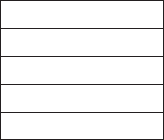
Figure 15-25 Memory layout for a 1-dimensional array.
Array - Temp
Data Type - INT[5]
Temp[0] 297
Temp[1] 200
Temp[2] 180
Temp[3] 120
Temp[4] 100
of an array must be of the same data type (e.g., BOOL,
SINT, or INT). An array occupies a contiguous block
of controller memory. Arrays are similar to tables of
values. The use of arrayed data types offers the fastest
data throughput (output) from a ControlLogix processor.
Because arrays are numerically sequenced tags of the
same data that occupy a contiguous memory location,
large amounts of data can be retrieved ef ciently. Arrays
can be built using 1, 2 or 3 dimensions, as illustrated in
Figure 15-24 , to represent the data they are intended to
contain.
A single tag within the array is one element. The ele-
ment may be a basic data type or a structure. The ele-
ments start with 0 and extend to the number of elements
minus 1. Figure 15-25 is an example of the memory
layout for a 1-dimensional (one column of values)
array created to hold ve temperatures. The tag name
is Temp and the array consists of 5 elements numbered
0 through 4.
Memory and Project Organization Part 1 327
pet10882_ch15_317-372.indd 327pet10882_ch15_317-372.indd 327 7/27/10 6:43 PM7/27/10 6:43 PM

1. Compare the memory con guration of a Logix
5000 controller with that of an SLC 500 controller.
2. What does a project contain?
3. List four programming functions that can be car-
ried out using the program organizer.
4. Explain the function of tasks within the project.
5. State the three main types of tasks.
6. What type of tasks function as timed interrupts?
7. Explain the function of programs within the
project.
8. Explain the function of routines within the project.
9. Which routine is con gured to execute rst?
10. Name the four types of programming languages
that can be used to program Logix 5000 controllers.
11. What are tags used for?
12. Compare the accessibility of program scope and
controller scope tags.
13. Name the tag type used for each of the following:
a. Create an alternate name for a tag.
b. Share information over a network.
c. Store various types of data.
PART 1 REVIEW QUESTIONS
14. What is the difference between a produced tag and
a consumed tag?
15. List the ve types of base tag data.
16. State the data type used for each of the following:
a. 32-bit memory storage
b. On/Off toggle switch
c. 16-bit memory storage
d. 8-bit memory storage
17. Describe the make-up of a prede ned structure.
18. Describe the make-up of a module-de ned
structure.
19. Describe the make-up of a user-de ned structure.
20. Explain two ways of creating tags.
21. When de ning tags what limitations are placed on
the entering of a tag name?
22. What is meant by the tag display style?
23. Write an example of an array tag used to hold
4speeds.
328 Part 1 Memory and Project Organization
pet10882_ch15_317-372.indd 328pet10882_ch15_317-372.indd 328 7/27/10 6:43 PM7/27/10 6:43 PM
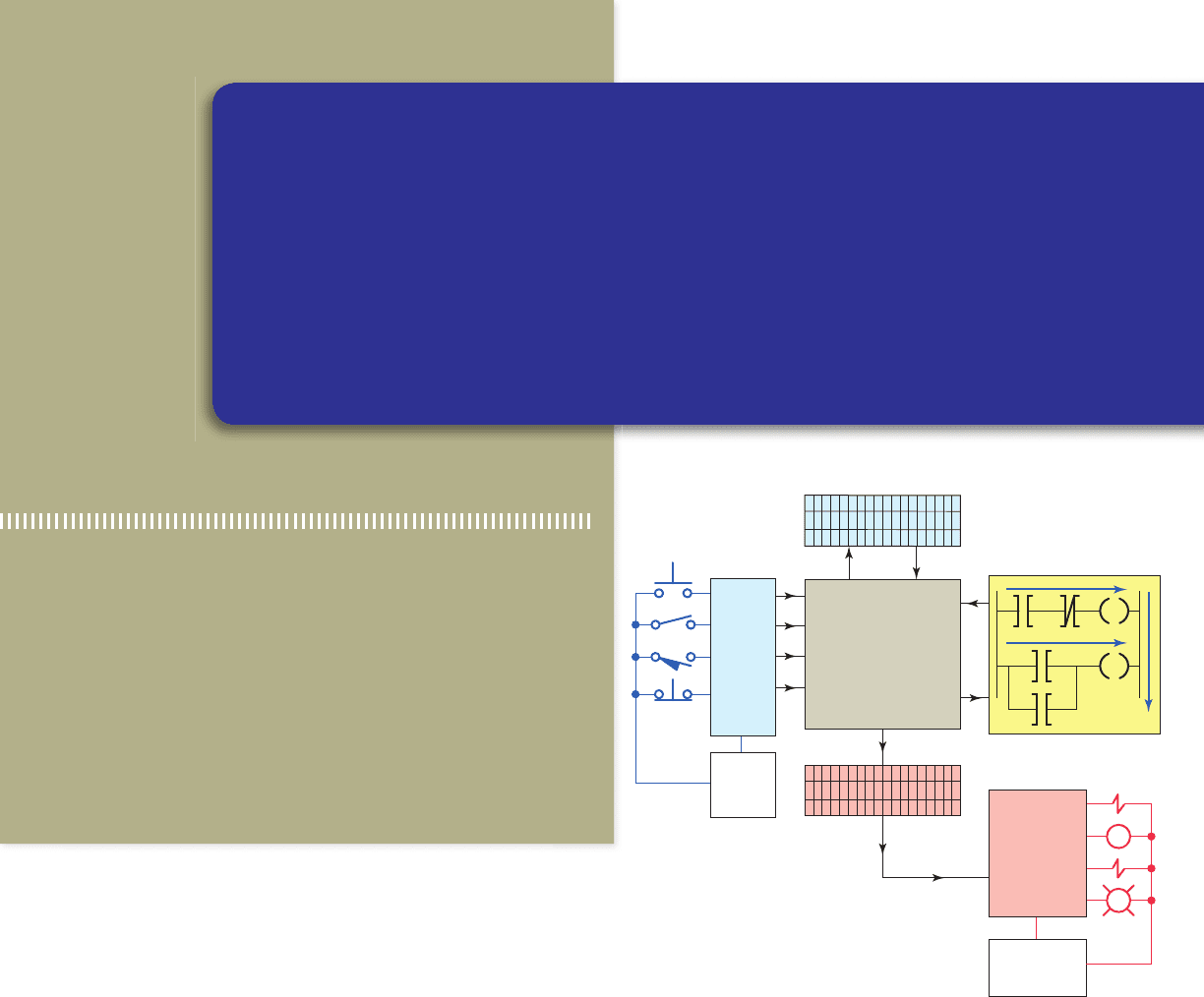
329
• The status signals from the inputs are sent to the
input tags where they are stored.
• As the program is scanned by the processor, inputs
are checked for True or False conditions and the
ladder logic is evaluated based on these values.
• The resulting ON or OFF action, as a result of
evaluating each rung, is then sent to the output tags
for storage.
• During the output update portion of the scan, cor-
responding output values are sent to the process or
machine by way of the output module.
Program Scan
When a CLX controller executes a program, it must
know—in real time—when external devices controlling
a process are changing. During each operating cycle,
the processor reads all the inputs, takes these values,
and energizes or de-energizes the outputs according to
the user program. This process is known as the program
scan.
Figure 15-26 illustrates the signal ow into and out of
a Logix controller during a controller’s operating cycle
when ladder logic is executing. During the program scan,
the controller reads rungs and branches from left to right
and top to bottom as follows:
• Only one rung at a time is scanned.
• As the program is scanned, the status of inputs are
checked for True (1 or ON) or False (0 of OFF)
conditions.
Part 2 Bit-Level
Programming
Part Objectives
After completing this part, you will be able to:
• Know what happens during the program scan
• Demonstrate an understanding of input, output, and
internal relay addressing format for a tag-based Logix
controller
• Develop ladder logic programs with input instructions
and output coil combinations
• Develop ladder logic programs with latched outputs
Figure 15-26 Logix controller operating cycle.
PLC
processor
Input tags
Ladder logic
program
Field output
devices
Field input
devices
Output
tags
PLC
input
module
Field
power
supply
Field power
supply
PLC
output
module
M
pet10882_ch15_317-372.indd 329pet10882_ch15_317-372.indd 329 7/27/10 6:43 PM7/27/10 6:43 PM
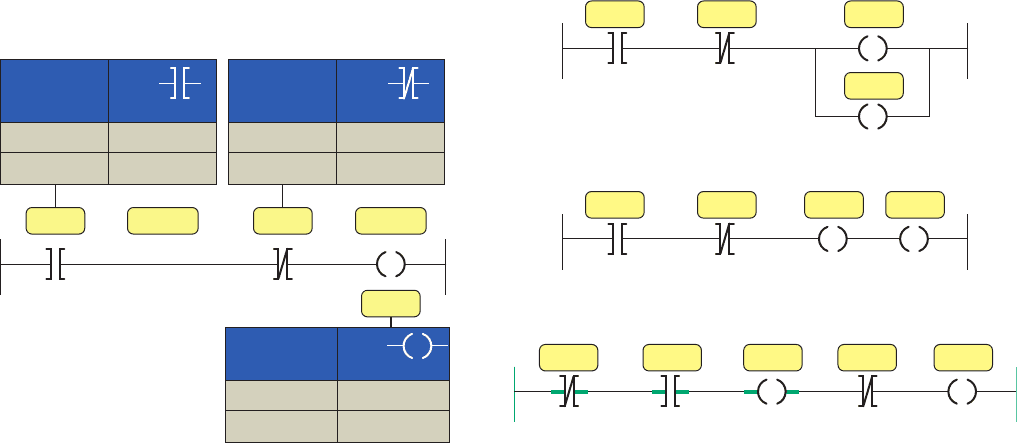
• When a rung has only one output instruction it will
always be true.
• The last instruction on a rung must always be an
output instruction.
• The XIC, or Examine If Closed contact instruction,
checks to see if the input has a value of one. If the
input is one, the XIC instruction returns a true value.
• The XIO, or Examine If Open contact instruction,
checks to see if the input has a value of zero. If the
input is zero, the XIO instruction returns a true value.
• The OTE or Output Energize coil instruction sets
the tag associated with it to true or one when the
rung has logic continuity. When true it can be used
to energize an output device or simply set a value in
memory to one.
ControlLogix PLCs support multiple outputs on one
rung. CLX controllers allow the use of serial logic that
does not conform to traditional electrical hardwired cir-
cuits or ladder logic. For example, both of the rungs shown
in Figure 15-28 are valid in RSLogix 5000. However the
series connection of outputs would not work if wired that
way in an equivalent electrical circuit or programmed that
way in RSLogix 500. In both instances in RSLogix 5000,
instructions tagA and tagB must be true to energize output
tag1 and tag2.
In ControlLogix output instructions can be placed be-
tween input instructions as illustrated in Figure15-29 . In
this example instructions tagA and tagB must be true to
energize output tag1. Instructions tagA and tagB and tagC
must all be true before output tag2 is set to energize.
• I/O updates occur asynchronously to the scan
of the logic. With a ControlLogix processor two
separate 32-bit unsynchronized processes gone
on simultaneously—that is, asynchronously.
This means that the module can update the input
tag from the eld and write the output tag to the
eld at any point (or at several points) during the
processor’s execution of the ladder rungs. The
result is more ef ciency and control over when the
input eld device data are updated in the input tag
and when the output data resulting from the solved
logic are sent to the output modules and their
respective eld devices.
Creating Ladder Logic
Although other programming languages are available,
ladder logic is the most common programming language
for PLCs. The instructions in ladder logic programming
can be divided into two broad categories: input and out-
put instructions. The most common input instruction is
equivalent to a relay contact and the most common output
instruction is the equivalent of a relay coil ( Figure 15-27 ).
When creating ladder I/O bit instructions, the following
rules apply:
• All input instructions must be to the left of an out-
put instruction.
• A rung cannot begin with an output instruction if it
also contains an input instruction. This is because
the controller tests all inputs for true or false before
deciding what value the output instruction should be.
• A rung does not need to contain any input
instructions, but it must contain at least one output
instruction.
Figure 15-27 Contacts and coil instructions.
If the Data
Bit is:
Logic 0
Logic 1
F
alse
Tr ue
XIC
instr
uction is:
XIC Inputs
If the Data
Bit is:
Logic 0
Logic 1
Tr
u e
False
XIO
instr
uction is:
XIO Output
OTE
If the Data
Bit is:
Logic 0
Logic 1
F
alse
Tr ue
OTE
instr
uction is:
Figure 15-28 Parallel and series outputs.
tag1
tag2
tagBtagA
Parallel outputs
tag1 tag2tagBtagA
Series outputs
Figure 15-29 Output instruction placed between input
instructions.
tag1 tag2tagBtagA tagC
330 Part 2 Bit-Level Programming
pet10882_ch15_317-372.indd 330pet10882_ch15_317-372.indd 330 7/27/10 6:43 PM7/27/10 6:43 PM
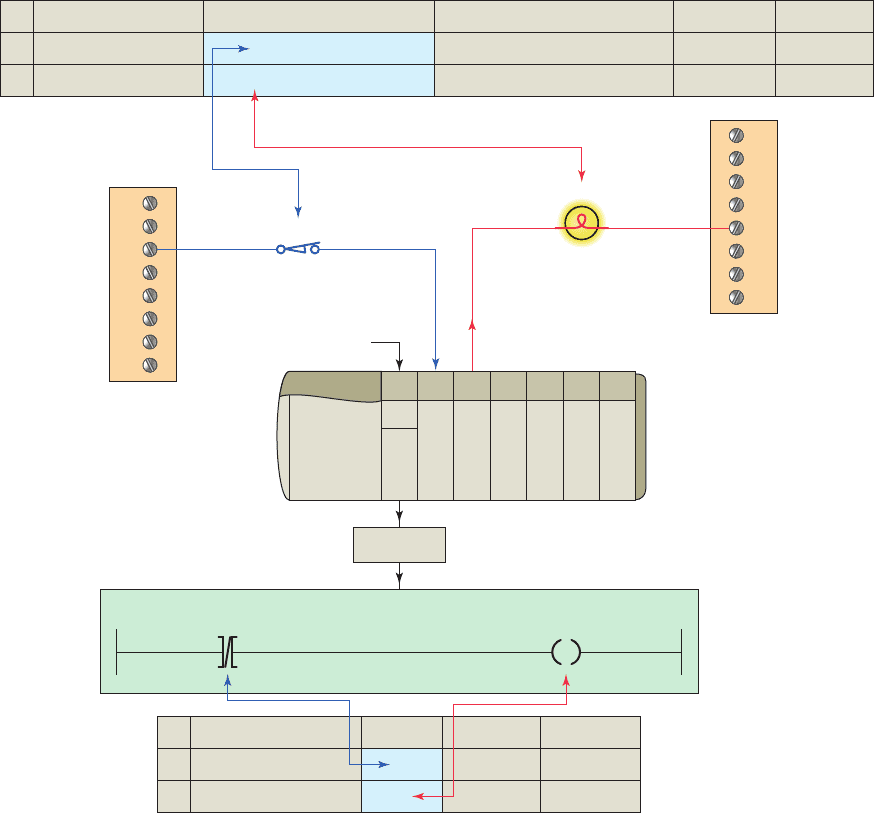
Tag-Based Addressing
Logix 5000 controllers use a tag-based addressing struc-
ture. A tag is a text-based name for an area of the control-
ler where data is stored. An example of how a tag-based
address is implemented using a ControlLogix controller
is shown in Figure 15-30 . Tag names use a meaningful
description of the variable. In this application when the
normally closed high limit switch is activated the program
will switch the high limit output light on. The addressing
format can be summarized as follows:
• The physical address for the tag Limit_switch is
Local:1:I.Data.2(C). Local indicates that the module
is in the same rack as the processor, 1 indicates that
the module is in slot 1 in the rack, I indicates that
the module is an input type, Data indicates that it
is a digital input, 2 indicates that the limit switch is
connected to terminal 2 on the module, and C indi-
cates that it is a controller tag with global access.
• The physical address for the tag High_limit_light is
Local:2:O.Data.4(C). Local indicates that the module
is in the same rack as the processor, 2 indicates that
the module is in slot 2 in the rack, O indicates that
the module is an output type, Data indicates that it is
a digital input, 4 indicates that the high limit light is
connected to terminal 4 on the module, and C indicates
that it is a controller tag with global access.
One advantage of the use of tag-based addressing is
that the allocation of variable names for program values
is not tied to speci c memory locations in the memory
structure, as is the case with rack/slot and rack/group type
Figure 15-30 Tag-based address implementation.
Power
supply
0
TAG EDIT
123456
8-point
discrete
(digital)
input
module
Limit_switch
High_limit_light
Switch - closed
Processor
module
Program
7-slot
ControlLogix
chassis
8-point
discrete
(digital)
onput
module
0
1
2
3
4
5
6
7
0
1
2
3
4
5
6
7
Tag Name
Limit_switch
High_limit_light
Alias For
Local:1:I.data.2(C)
Local:2:O.data.4(C)
Base Tag
Local:1:I.data.2(C)
Local:2:O.data.4(C)
Type
BOOL
BOOL
Style
Decimal
Decimal
Limit_switch
<Local:1:I.data.2(C)>
High_limit_light
<Local:2:O.data.4(C)>
TAG MONITOR
Tag Name
Limit_switch
High_limit_light
Style
Decimal
Decimal
Type
BOOL
BOOL
Value
1
0
Light-OFF
Bit-Level Programming Part 2 331
pet10882_ch15_317-372.indd 331pet10882_ch15_317-372.indd 331 7/27/10 6:43 PM7/27/10 6:43 PM
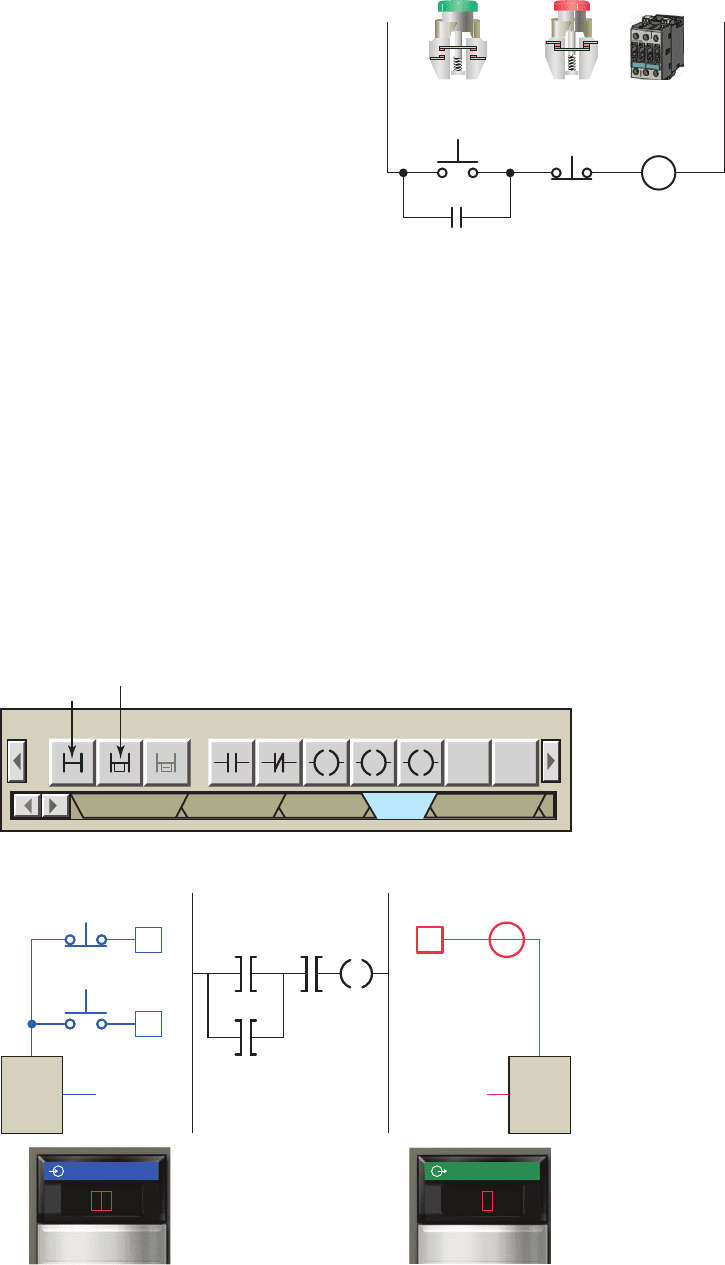
before adding the next instruction. In this example we have
chosen to use question marks [?] in place of tag names and
assign the tags later. Field device wiring for the two push-
button inputs and the single contactor coil output are as
illustrated. The stop button is connected to terminal 3 and
the start button to terminal 4 of the DC input module lo-
cated in slot 1 of the rack. The contactor coil is connected
to terminal 4 of the DC output module located in slot 2
of the rack. Both the start and stop buttons are examined
for a closed condition (XIC) because both buttons must be
closed to cause the motor starter to operate.
systems. Initially, all program development can proceed
with just the tag names and data types assigned. Using tag
aliases, programmers can write code independent of elec-
trical connection assignments. At a later date, input and
output eld devices are easily matched to the pin numbers
on the respective module they are connected to.
Adding Ladder Logic to the
MainRoutine
Figure 15-31 shows the diagram for a hardwired contac-
tor operated motor start/stop control circuit. The normally
open start button is momentarily closed to energize the
contactor coil and close its main contacts to start the motor.
The seal-in auxiliary contact of the contactor is connected
in parallel with the start button to keep the starter coil
energized when the start button is released. The normally
closed start button is momentarily opened to de-energize
the contactor coil and stop the motor.
Figure 15-32 shows the ladder logic program for the
motor start/stop control circuit and the RSLogix 5000 tool-
bar used to create it. Free form editing found in RSLogix
5000 helps speed development in that you do not have to
place an instruction and tie an address to the instruction
Contactor auxiliary
contact
Contactor coil
Motor
run
Motor
stop
Motor
start
L1
L2
M
Figure 15-31 Hardwired motor start/stop control circuit.
Figure 15-32 Programmed motor start/stop control circuit.
ⴙⴙ
Common Common
Rung
Branch
Bit element toolbar
M
3 4
Field
device
power
4
Terminal Terminal
Ladder logic program
ContactorStop
Start
?
?
??
Input module
Slot 1
Output module
Slot 2
ONS OSR
Bit
L U
XIC XIO OTE OTL OTU
Field
device
power
ST01234567 ST01234567
DC OUTPUTDC INPUT
332 Part 2 Bit-Level Programming
pet10882_ch15_317-372.indd 332pet10882_ch15_317-372.indd 332 7/27/10 6:43 PM7/27/10 6:43 PM
